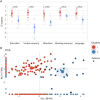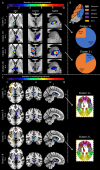Factors behind poor cognitive outcome following a thalamic stroke
- PMID: 39775143
- PMCID: PMC11706879
- DOI: 10.1007/s00415-024-12777-4
Factors behind poor cognitive outcome following a thalamic stroke
Abstract
Background: Thalamic strokes produce neurological, cognitive, and behavioral symptoms depending on the thalamic nuclei involved. While traditionally associated with severe cognitive deficits, recent studies suggest more modest impairments. This study aims to identify the factors that influence the severity of cognitive impairment following thalamic stroke.
Methods: We recruited 40 patients (mean age 51.1) with chronic isolated thalamic stroke and 45 healthy subjects (mean age 48.5) who underwent neuroimaging and neuropsychological assessment. Cluster and principal component analyses were used to discriminate patients from healthy subjects based on cognitive tasks. Disconnectome maps and cortical thickness were analyzed to understand the distant impact of thalamic strokes.
Results: Two cognitive profiles emerged from the cluster analysis. Cluster 1 included mostly healthy subjects (n = 43) and patients with no or minor deficits (n = 20). Cluster 2 included patients (n = 19) and two healthy subjects with severe deficits in verbal memory, executive functions, and attention. Cluster 1 encompassed all patients with right thalamic stroke, while Cluster 2 included all patients with bilateral stroke or mammillothalamic tract interruption. Patients with left-sided stroke were equally divided between clusters. Significant differences between clusters included age, education, interthalamic adhesion disruption, lesion volume, and location. Patients with left-sided stroke in Cluster 2 had more lateral thalamic lesions and greater disruption of the anterior thalamic projection.
Conclusions: Contrary to common expectations, our findings suggest that many patients with thalamic stroke have relatively good cognitive outcomes. In contrast, we identified the factors behind poor outcomes that will help clinicians.
Keywords: Cognition; MRI; Outcomes; Stroke; Thalamus.
© 2024. The Author(s).
Conflict of interest statement
Declarations. Conflict of interest: The authors have no conflicts of interest relevant to this manuscript to disclose. Ethical approval: Subjects from two studies were included in order to increase the sample size. The first study was approved by the Institutional Review Board “Comité de Protection des Personnes Sud-Ouest et Outre-Mer no. 2-11-0”. The second study was authorized by the “Comité de Protection des Personnes Ile-de-France IV”. All subjects signed informed consent before any experimental procedure. Disclosures: The authors have no conflicts of interest relevant to this manuscript to disclose.
Figures




Similar articles
-
Exploring the impact of the interthalamic adhesion on human cognition: insights from healthy subjects and thalamic stroke patients.J Neurol. 2024 Sep;271(9):5985-5996. doi: 10.1007/s00415-024-12566-z. Epub 2024 Jul 17. J Neurol. 2024. PMID: 39017701 Free PMC article.
-
Evolution of Neuropsychological Deficits in First-Ever Isolated Ischemic Thalamic Stroke and Their Association With Stroke Topography: A Case-Control Study.Stroke. 2022 Jun;53(6):1904-1914. doi: 10.1161/STROKEAHA.121.037750. Epub 2022 Mar 9. Stroke. 2022. PMID: 35259928 Free PMC article.
-
Remote thalamic microstructural abnormalities related to cognitive function in ischemic stroke patients.Neuropsychology. 2014 Nov;28(6):984-996. doi: 10.1037/neu0000087. Epub 2014 Jun 2. Neuropsychology. 2014. PMID: 24885449
-
Vascular syndromes of the thalamus.Stroke. 2003 Sep;34(9):2264-78. doi: 10.1161/01.STR.0000087786.38997.9E. Epub 2003 Aug 21. Stroke. 2003. PMID: 12933968 Review.
-
Neglect after Isolated Thalamic Stroke: A Systematic Review of the Literature.Cerebrovasc Dis. 2025 May 2:1-18. doi: 10.1159/000545473. Online ahead of print. Cerebrovasc Dis. 2025. PMID: 40319890
Cited by
-
A bibliometric analysis of electroencephalogram research in stroke: current trends and future directions.Front Neurol. 2025 Apr 28;16:1539736. doi: 10.3389/fneur.2025.1539736. eCollection 2025. Front Neurol. 2025. PMID: 40356632 Free PMC article.
References
-
- Schmahmann JD (2003) Syndromes vasculaires du thalamus. Stroke 34(9):2264–2278 - PubMed
-
- Lawson R (1878) On the symptomatology of alcoholic brain disorders. Brain 1(2):182–194
-
- Hillemand P (1925) (1925) Contribution à l’étude des syndromes thalamiques. Thèse, Paris
-
- Watson RT, Heilman KM (1979) Thalamic neglect Neurol 29:690–694 - PubMed
MeSH terms
LinkOut - more resources
Full Text Sources
Medical

